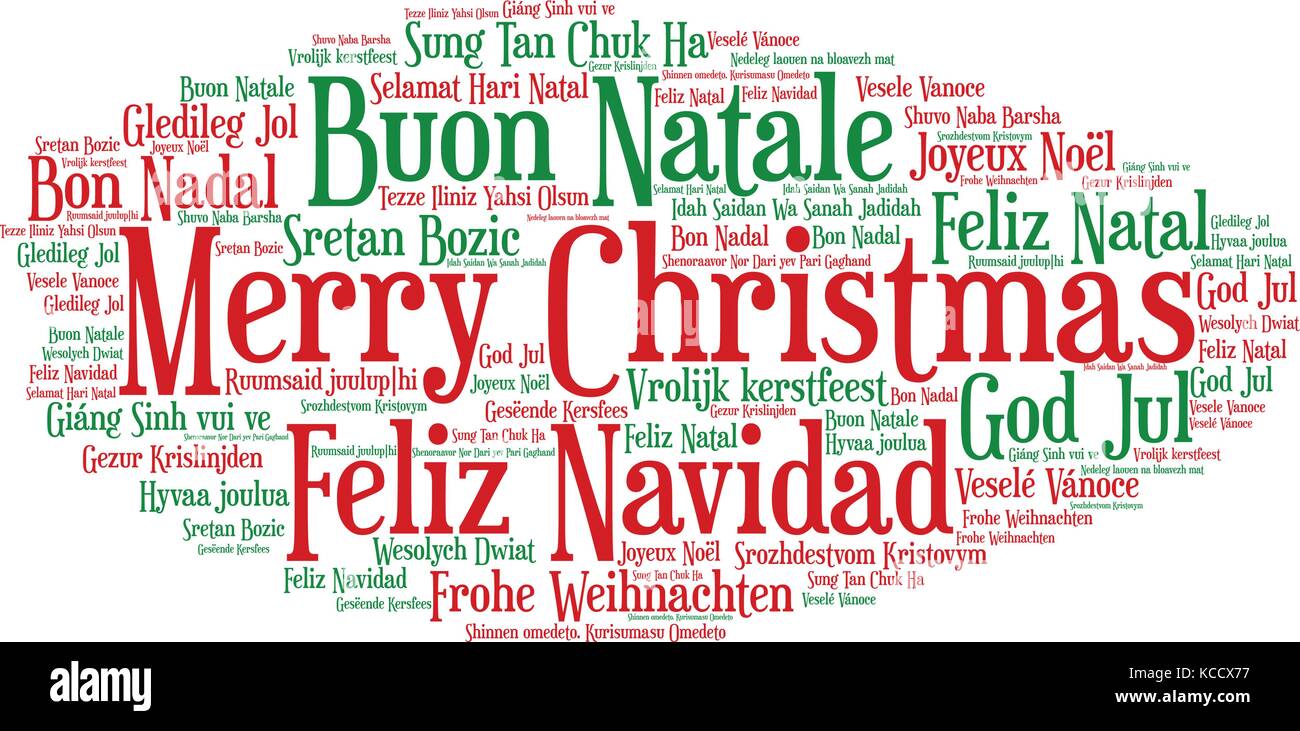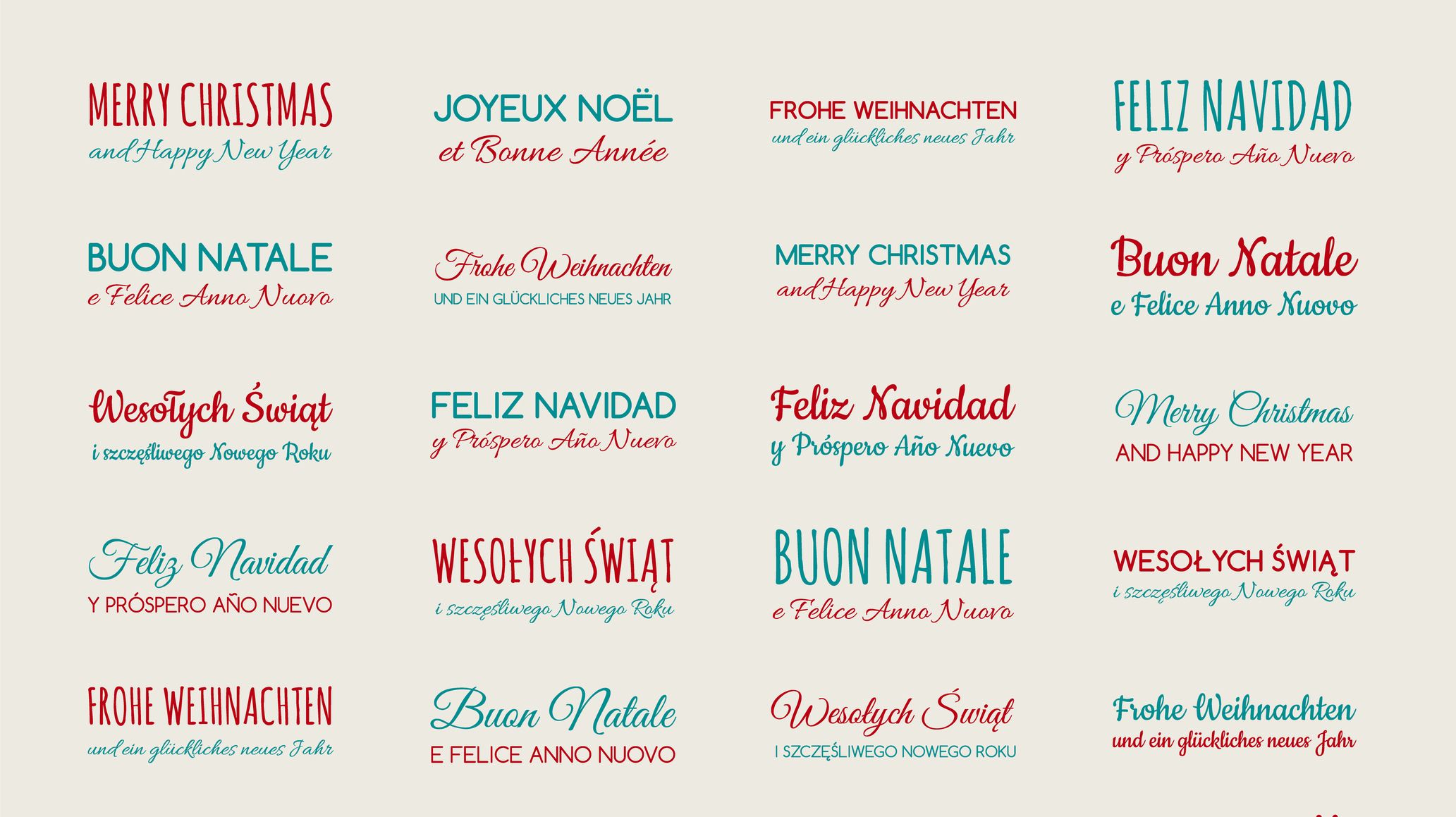Merry Christmas in all the languages! As the festive season approaches, let us embark on a linguistic and cultural journey to explore how different languages and cultures express the joy and spirit of Christmas. From the heartfelt greetings to the unique traditions, we will delve into the rich tapestry of Christmas celebrations worldwide.
Across continents and cultures, Christmas has evolved into a multifaceted holiday, reflecting the diverse beliefs, customs, and traditions of each region. This article will provide a glimpse into the enchanting world of Christmas celebrations, highlighting the linguistic nuances and cultural significance that make this holiday truly special.
Merry Christmas Greetings Around the World
Merry Christmas is a time for joy, celebration, and reflection. Around the world, people celebrate this special day in unique and meaningful ways. One of the most common traditions is exchanging Christmas greetings. These greetings vary from language to language, but they all share a common message of peace, love, and goodwill.
In Spanish, the traditional Christmas greeting is “Feliz Navidad.” This phrase translates to “Happy Christmas” and is often used in conjunction with the phrase “Próspero Año Nuevo,” which means “Happy New Year.” In French, the traditional Christmas greeting is “Joyeux Noël.”
This phrase translates to “Merry Christmas” and is often used in conjunction with the phrase “Bonne Année,” which means “Happy New Year.” In German, the traditional Christmas greeting is “Frohe Weihnachten.” This phrase translates to “Merry Christmas” and is often used in conjunction with the phrase “Ein gutes neues Jahr,” which means “A good new year.”
In Chinese, the traditional Christmas greeting is “圣诞快乐” (Shèng dàn kuài lè). This phrase translates to “Merry Christmas” and is often used in conjunction with the phrase “新年快乐” (Xīn nián kuài lè), which means “Happy New Year.” In Russian, the traditional Christmas greeting is “С Рождеством Христовым” (S Rozhdestvom Khristovym).
This phrase translates to “Merry Christmas” and is often used in conjunction with the phrase “С Новым годом” (S Novyy godom), which means “Happy New Year.”
These are just a few examples of the many different ways that people around the world celebrate Christmas. While the traditions may vary, the message of peace, love, and goodwill is universal.
Cross-Cultural Comparisons of Christmas Celebrations
Christmas, a beloved holiday celebrated worldwide, exhibits a kaleidoscope of unique customs, traditions, and rituals across different cultures. These variations are influenced by a tapestry of factors, including history, geography, and religious beliefs.
Gift-Giving Practices
Gift-giving is an integral part of Christmas celebrations globally. However, the nature of these gifts varies considerably. In many Western countries, such as the United States and the United Kingdom, it is customary to exchange presents on Christmas Day. In contrast, in some Eastern European nations like Poland, gift-giving takes place on Christmas Eve.
The types of gifts also differ across cultures. In some countries, such as Germany, practical gifts like household items or tools are common. In others, such as France, more luxurious or sentimental gifts, like jewelry or perfume, are preferred.
Decorations
Christmas decorations are another area where cultural differences manifest. In many countries, evergreen trees are decorated with ornaments, lights, and tinsel. However, in some cultures, alternative forms of decoration are used. For instance, in Japan, it is common to display miniature Christmas cakes called “kurimukeki.”
In Mexico, nativity scenes, known as “nacimientos,” are a popular form of Christmas decoration.
Religious Observances
The religious significance of Christmas also varies across cultures. In countries with strong Christian traditions, such as Italy and Spain, Christmas is a time for religious services, prayers, and reflection. In other countries, such as China, where Christianity is not as prevalent, Christmas is celebrated primarily as a cultural and secular holiday.
The Evolution of Christmas Traditions

Christmas, a widely celebrated holiday with religious and cultural significance, has undergone a remarkable evolution over the centuries. From its humble beginnings as a sacred festival to its modern-day secular aspects, the traditions associated with Christmas have been shaped by diverse cultural influences and societal norms.
Religious Origins
Christmas originated as a Christian holiday commemorating the birth of Jesus Christ. Early Christian celebrations focused on religious observances such as church services, prayer, and fasting. The exchange of gifts, a practice believed to have originated with the Three Wise Men, became a popular tradition symbolizing the gifts brought to the infant Jesus.
Medieval Transformations
During the Middle Ages, Christmas traditions began to incorporate elements from pagan winter solstice festivals. The use of evergreens, candles, and feasting became common, reflecting pre-Christian beliefs about warding off evil spirits and celebrating the return of light.
Modern Secularization
With the rise of secularism in the 19th and 20th centuries, Christmas traditions gradually shifted towards a more secular focus. The emphasis on religious observance diminished, and the holiday became increasingly associated with family gatherings, gift-giving, and festive decorations.
Cultural Influences
The way Christmas is celebrated varies widely around the world, reflecting the cultural influences of different regions. In some countries, such as Germany, the tradition of Christmas markets and the advent calendar is prevalent. In Latin America, Christmas is often celebrated with elaborate Nativity scenes and processions.
Societal Norms and Values
Christmas traditions have also adapted to reflect societal norms and values. In recent decades, there has been a growing emphasis on inclusivity and diversity, with Christmas celebrations becoming more representative of different cultures and backgrounds.
Historical Examples
- The tradition of the Christmas tree originated in Germany in the 16th century and gradually spread to other parts of the world.
- The practice of exchanging Christmas cards became popular in the 19th century as a way to convey holiday greetings.
- The character of Santa Claus evolved from the Dutch figure of Sinterklaas and became associated with Christmas in the United States in the 19th century.
The Impact of Globalization on Christmas Celebrations: Merry Christmas In All The Languages
Globalization has significantly influenced Christmas celebrations worldwide, both positively and negatively. Increased travel and communication have facilitated the spread of Christmas traditions across borders, while simultaneously presenting challenges and opportunities for preserving cultural diversity in these celebrations.
Increased Travel and the Spread of Christmas Traditions
The ease of global travel has enabled people to experience different Christmas traditions firsthand. This exposure has led to the adoption of new customs and practices, such as the popularity of Christmas markets in Europe or the tradition of leaving cookies and milk for Santa Claus in North America.
Additionally, the rise of international travel has increased the demand for Christmas-related products and services, contributing to the commercialization of the holiday.
Challenges to Cultural Diversity
While globalization has enriched Christmas celebrations with diverse traditions, it has also raised concerns about the potential loss of cultural identity. The dominance of Western Christmas traditions, particularly in popular media and commercial advertising, can overshadow local customs and practices.
This homogenization can lead to a sense of cultural dilution and a diminished appreciation for the unique ways in which different cultures celebrate Christmas.
Opportunities for Preserving Cultural Diversity, Merry christmas in all the languages
Despite the challenges, globalization also presents opportunities for preserving cultural diversity in Christmas celebrations. The increased awareness of different traditions can foster a greater appreciation for the richness and variety of cultural expressions. Furthermore, globalization has facilitated the exchange of ideas and resources, allowing communities to share and learn from one another’s Christmas traditions.
This cross-cultural exchange can contribute to a more inclusive and diverse understanding of the holiday.
Christmas in Popular Culture

Christmas has been extensively portrayed in popular culture, including movies, TV shows, music, and literature. These representations have shaped perceptions of Christmas and contributed to its cultural significance. Over time, Christmas imagery and symbolism in popular culture have undergone significant evolution.
Movies and TV Shows
Christmas movies and TV shows often depict the holiday as a time for family, love, and giving. They frequently feature heartwarming stories about people coming together to celebrate the season. Some popular Christmas movies include “It’s a Wonderful Life,” “Elf,” and “Home Alone.”
Popular Christmas TV shows include “A Charlie Brown Christmas,” “Rudolph the Red-Nosed Reindeer,” and “The Grinch Who Stole Christmas.”
Music
Christmas music is a staple of the holiday season. Many popular Christmas songs have been written and recorded over the years, including “Jingle Bells,” “Silent Night,” and “White Christmas.” Christmas music is often played in stores, on the radio, and at holiday parties.
Literature
Christmas has also been a popular subject in literature. Many classic Christmas stories have been written, including “A Christmas Carol” by Charles Dickens and “The Gift of the Magi” by O. Henry. These stories often explore the themes of love, giving, and redemption.
Wrap-Up

As we conclude our exploration of Christmas around the globe, we are reminded of the universal message of love, peace, and joy that this holiday embodies. Through the diverse expressions of Christmas in different languages and cultures, we have witnessed the resilience and adaptability of human traditions.
May this festive season be filled with warmth, laughter, and a renewed appreciation for the beauty of cultural diversity.
FAQ Explained
What is the most common way to say “Merry Christmas” in English?
The most common way to say “Merry Christmas” in English is “Merry Christmas to you and your family.”
What is the traditional Christmas greeting in Spanish?
The traditional Christmas greeting in Spanish is “Feliz Navidad.”
What is the origin of the Christmas greeting “Merry Christmas”?
The origin of the Christmas greeting “Merry Christmas” can be traced back to the early Christian church.